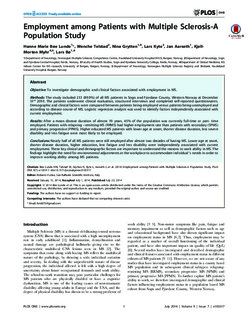| dc.contributor.author | Lunde, Hanne Marie | |
| dc.contributor.author | Telstad, Wenche | |
| dc.contributor.author | Torkildsen, Nina Agnethe Grytten | |
| dc.contributor.author | Kyte, Lars | |
| dc.contributor.author | Aarseth, Jan | |
| dc.contributor.author | Myhr, Kjell-Morten | |
| dc.contributor.author | Bø, Lars | |
| dc.date.accessioned | 2015-03-03T15:48:03Z | |
| dc.date.accessioned | 2016-12-06T14:14:47Z | |
| dc.date.available | 2015-03-03T15:48:03Z | |
| dc.date.available | 2016-12-06T14:14:47Z | |
| dc.date.issued | 2014 | |
| dc.identifier.citation | PLoS ONE 2014, 9(7:103317) | nb_NO |
| dc.identifier.issn | 1932-6203 | |
| dc.identifier.uri | http://hdl.handle.net/11250/2424373 | |
| dc.description.abstract | OBJECTIVE:
To investigate demographic and clinical factors associated with employment in MS.
METHODS:
The study included 213 (89.9%) of all MS patients in Sogn and Fjordane County, Western Norway at December 31st 2010. The patients underwent clinical evaluation, structured interviews and completed self-reported questionnaires. Demographic and clinical factors were compared between patients being employed versus patients being unemployed and according to disease course of MS. Logistic regression analysis was used to identify factors independently associated with current employment.
RESULTS:
After a mean disease duration of almost 19 years, 45% of the population was currently full-time or part- time employed. Patients with relapsing -remitting MS (RRMS) had higher employment rate than patients with secondary (SPMS) and primary progressive (PPMS). Higher educated MS patients with lower age at onset, shorter disease duration, less severe disability and less fatigue were most likely to be employed.
CONCLUSIONS:
Nearly half of all MS patients were still employed after almost two decades of having MS. Lower age at onset, shorter disease duration, higher education, less fatigue and less disability were independently associated with current employment. These key clinical and demographic factors are important to understand the reasons to work ability in MS. The findings highlight the need for environmental adjustments at the workplace to accommodate individual 's needs in order to improve working ability among MS patients | nb_NO |
| dc.language.iso | eng | nb_NO |
| dc.rights | Navngivelse 4.0 Internasjonal | * |
| dc.rights.uri | http://creativecommons.org/licenses/by/4.0/deed.no | * |
| dc.title | Employment among patients with multiple sclerosis: A population study | nb_NO |
| dc.type | Journal article | nb_NO |
| dc.type | Peer reviewed | nb_NO |
| dc.date.updated | 2015-03-03T15:48:03Z | |
| dc.subject.nsi | VDP::Medisinske fag: 700::Klinisk medisinske fag: 750::Nevrologi: 752 | nb_NO |
| dc.subject.nsi | VDP::Midical sciences: 700::Clinical medical sciences: 750::Neurology: 752 | nb_NO |
| dc.source.volume | 9 | nb_NO |
| dc.source.journal | PLoS ONE | nb_NO |
| dc.source.issue | 7 | nb_NO |
| dc.identifier.doi | 10.1371/journal.pone.0103317 | |
| dc.identifier.cristin | 1145613 | |

